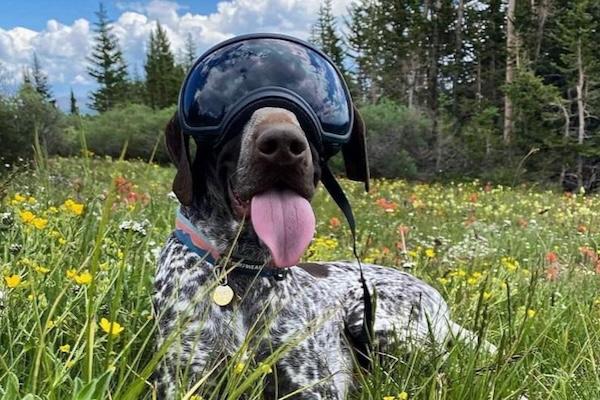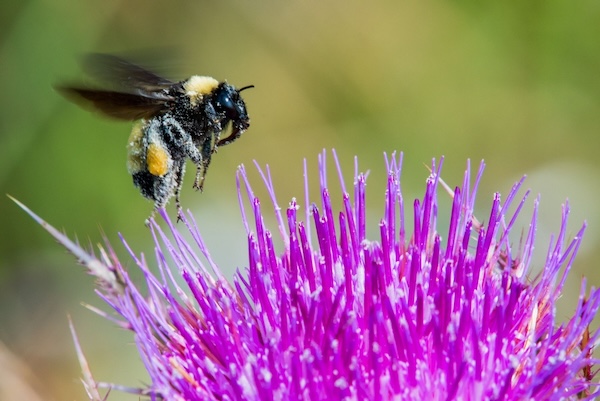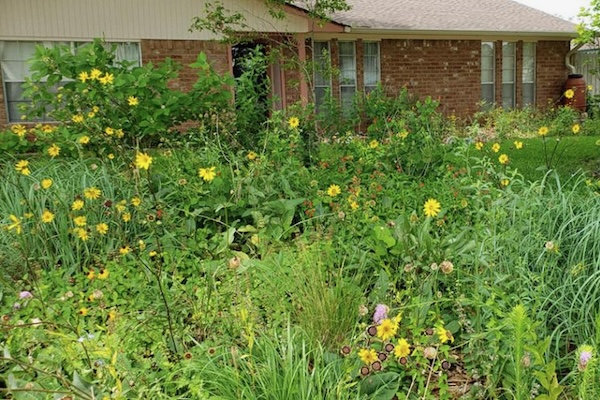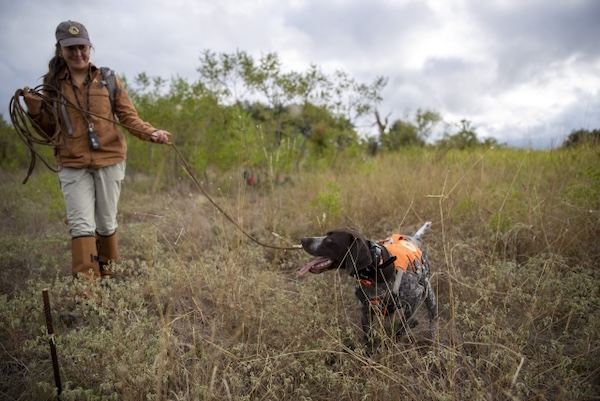
Gerty the dog has been trained to sniff out bee nests, one of the research projects being funded by Texas Parks and Wildlife Foundation's Pollinators and Prairie Program. Courtesy of TPWD.
Texas prairie habitat is rapidly disappearing, but a statewide nonprofit seeks to bring it back by enlisting every Texan in a conservation collaboration.
Texas Parks and Wildlife Foundation rolled out its Pollinators and Prairies program this week. The private nonprofit is supporting a variety of public outreach efforts, native plant restoration projects and scientific research with the goal of rescuing the state’s once vast but now devastated prairie lands.
“The overall purpose of the new program is to increase healthy prairie habitat and pollinator populations by encouraging Texans to be part of the solution by planting native grasses and wildflowers and to help fund research on native pollinators and prairies,” says Iliana Peña, Pollinators and Prairies Conservation Director.
DISAPPEARING LANDSCAPE
 A bumblebee hones in on a thistle. Photo by Jonathan Vail. Courtesy of TPWF.
A bumblebee hones in on a thistle. Photo by Jonathan Vail. Courtesy of TPWF.
Once the dominant landscape that spanned the state between the East Texas Piney Woods and the West Texas desert and ran along the general route of Interstate 35, north to Canada, our native prairie land has been nearly eradicated from Texas after being destroyed by a century and a half of urban and suburban sprawl, ranching and agriculture.
Additionally, climate change is affecting the state’s flora. And the fragmentation of remaining prairie remnants hampers its ability to support the range of life that has evolved in the state’s once wide-open landscape — a landscape that was once covered in tall grasses and a seasonal succession of wildflower species, with sparse shrubbery and trees.
The result of these adverse trends has been declining populations of prairie wildlife that includes everything from bumblebees and monarch butterflies to bobwhite quail, prairie dogs and other familiar species among the vast numbers of anonymous beetles, ants, birds, moths and lesser-known wildlife that nevertheless comprise a healthy prairie ecosystem.
“The impetus for the program is that grassland habitat and associated wildlife have been declining for decades, and the Texas Parks and Wildlife Department and the Texas Parks and Wildlife Foundation have together been tackling this conservation challenge through land protection, through restoration projects and outreach. And this program is just another critical piece to that work,” Peña says.
FOUR-PRONGED STRATEGY
The TPWF Pollinators and Prairies program is taking a four-pronged approach to support the conservation challenge that consists of outreach, restoration, research and partnerships.
"Within our restoration program, this entire program is not seeking to duplicate anything,” Peña says. “There's a lot going on in the pollinator space in Texas. So, what we are trying to do is bring together a collaborative coalition of partners. We are providing funding to partners like the Wildlife Habitat Federation. They will be working in engaging private and public landowners — and [as to] public landowners we're talking about county parks, we're talking about state parks — working with those partners, those landowners to restore acres to prairie. We will be working closely with partners who are already working in this space,” Peña says.
OUTREACH
 Conservation advocates say more homeowners need to replace traditional lawn with pocket prairies to support native wildlife. Courtesy of Native Prairies Association of Texas.
Conservation advocates say more homeowners need to replace traditional lawn with pocket prairies to support native wildlife. Courtesy of Native Prairies Association of Texas.
For outreach, Peña says TPWF is collaborating with the Native Plant Society of Texas to spread the word on how planting Texas native grasses and flowers — whether as integrations in a home or business landscape or perhaps as the creation of a small pocket prairie — can bring benefits to both the landowner and wildlife.
“NPSOT has got an abundance of information. They're actually partnering with H-E-B this entire week and through to the 30 of October as well. Some H-E-B stores will have Native Plant Society volunteers at the store to answer any questions that people have about planting natives, why natives are important, so the outreach and education component is going on through volunteer organizations like that and the Texas Wildlife Association. They’re a state organization that works with landowners and school children, and they do landowner workshops. They do seminars on land restoration,” Peña says.
RESEARCH
 Jacqueline works with Gerty the dog to sniff out bee nests at Lady Bird Johnson Wildlife Center. Courtesy of TPWD.
Jacqueline works with Gerty the dog to sniff out bee nests at Lady Bird Johnson Wildlife Center. Courtesy of TPWD.
For research, the foundation will fund scientific studies conducted by the Texas Parks and Wildlife Department. Peña says one such study in the works will explore why all pollinators are in decline in Texas and more specifically, why the American bumblebee appears to be being displaced by a species of bee that usually occupies more arid regions, and what affects such a change may have on the wildflowers in the state.
One research project currently underway is enlisting conservation K-9s specifically trained to locate difficult-to-find bumblebee nests in or on the ground. They also hope to detect the rarer variable cuckoo bumblebee, which also uses these nests. The goal of this research is to learn more about the habitat requirements for bumblebee nesting to inform conservation planning and understand potential threats to these iconic pollinator species in Texas.
"It is so important to support the research because management strategies and conservation planning are dependent on good science. So we want to make sure and support the research that helps us understand why pollinators are declining,” Peña adds.
PARTNERSHIPS
The two major funding partners in the TPWF Prairies and Pollinators program are H-E-B and Phillips 66. Peña says additional funds have come from the Horizon Foundation, and the Austin chapter of Stewards of the Wild.
"We want Texans to know they can be part of this program, and they can help make a difference,” Peña says. “Through our partners, there's a lot of wonderful information about how to get engaged here in the future. In the next year, the foundation will be developing an app that will guide people through the planting of natives and the planting of pocket prairies, so we ask people to keep looking for it on our website as we grow and provide more information on how people can become involved.”
Find more information about the TPWF program at Pollinators and Prairies.
RELATED ARTICLES
Climate change is affecting Texas native plants, says prof
For nature to survive, we all must practice stewardship at home, says author
Ecosystem's survival tied to prevalence of native plants, author says
